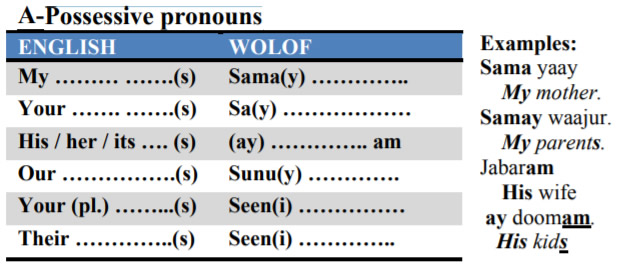Difference between revisions of "Language/Wolof/Grammar/Possessive-pronouns"
m (Quick edit) |
m (Quick edit) |
||
| (One intermediate revision by the same user not shown) | |||
| Line 1: | Line 1: | ||
[[File:Wolof-Language-PolyglotClub.jpg|thumb]] | [[File:Wolof-Language-PolyglotClub.jpg|thumb]] | ||
<div | <div class="pg_page_title"> Possessive Pronouns in Wolof </div> | ||
In this lesson we will introduce some grammar points, the first of them will be the POSSESSIVE PRONOUNS. | In this lesson we will introduce some grammar points, the first of them will be the POSSESSIVE PRONOUNS. | ||
[[File:Wolof-Possessive-Pronouns-PolyglotClub.jpg]] | [[File:Wolof-Possessive-Pronouns-PolyglotClub.jpg]] | ||
'''Examples:''' | '''Examples:''' | ||
| Line 14: | Line 12: | ||
*ay doomam. His kids | *ay doomam. His kids | ||
<span link>Once you've mastered this lesson, take a look at these related pages:</span> [[Language/Wolof/Grammar/Static-verbs|Static verbs]], [[Language/Wolof/Grammar/Conjugation|Conjugation]], [[Language/Wolof/Grammar/Adjective-Agreement|Adjective Agreement]] & [[Language/Wolof/Grammar/Word-Order|Word Order]]. | |||
==Notes== | ==Notes== | ||
In Wolof, the possessive pronouns are to some points different from the English possessives. | In Wolof, the possessive pronouns are to some points different from the English possessives. | ||
• The first one is the third person (his – her – its) has just 1 translation in Wolof (am) and it is the only possessive Wolof that comes after the noun (xaritam = his/her friend). | • The first one is the third person (his – her – its) has just 1 translation in Wolof (am) and it is the only possessive Wolof that comes after the noun (xaritam = his/her friend). | ||
• In Wolof, it’s not the noun that takes the sign of plural (s) but it the possessive pronoun that takes it, it is represented by the (y or i) that is added to the possessive: samay waajur = my parents. | • In Wolof, it’s not the noun that takes the sign of plural (s) but it the possessive pronoun that takes it, it is represented by the (y or i) that is added to the possessive: samay waajur = my parents. | ||
• The plural of “his – her – its” that are translated by “am” is “ay”. Both words surround the qualified noun: ay waajuram = his / her parents. | • The plural of “his – her – its” that are translated by “am” is “ay”. Both words surround the qualified noun: ay waajuram = his / her parents. | ||
==Source== | ==Source== | ||
| Line 35: | Line 29: | ||
===Possessive Pronouns in Wolof - YouTube=== | ===Possessive Pronouns in Wolof - YouTube=== | ||
<youtube>https://www.youtube.com/watch?v=1QOK2dOh08A</youtube> | <youtube>https://www.youtube.com/watch?v=1QOK2dOh08A</youtube> | ||
==Other Lessons== | |||
* [[Language/Wolof/Grammar/Enonciative-pronouns|Enonciative pronouns]] | |||
* [[Language/Wolof/Grammar/Conditional-Mood|Conditional Mood]] | |||
* [[Language/Wolof/Grammar/Negation|Negation]] | |||
* [[Language/Wolof/Grammar/Plural-Nouns-—-Definite-articles|Plural Nouns — Definite articles]] | |||
* [[Language/Wolof/Grammar/Static-verbs|Static verbs]] | |||
* [[Language/Wolof/Grammar/Conditional|Conditional]] | |||
* [[Language/Wolof/Grammar/Gender|Gender]] | |||
* [[Language/Wolof/Grammar/Notable-characteristics|Notable characteristics]] | |||
* [[Language/Wolof/Grammar/Plural-Nouns-—-Indefinite-article|Plural Nouns — Indefinite article]] | |||
* [[Language/Wolof/Grammar/Adjectives|Adjectives]] | |||
<span links></span> | |||
Latest revision as of 13:07, 27 March 2023
In this lesson we will introduce some grammar points, the first of them will be the POSSESSIVE PRONOUNS.
Examples:
- Sama yaay My mother.
- Samay waajur. My parents.
- Jabaram His wife
- ay doomam. His kids
Once you've mastered this lesson, take a look at these related pages: Static verbs, Conjugation, Adjective Agreement & Word Order.
Notes[edit | edit source]
In Wolof, the possessive pronouns are to some points different from the English possessives.
• The first one is the third person (his – her – its) has just 1 translation in Wolof (am) and it is the only possessive Wolof that comes after the noun (xaritam = his/her friend).
• In Wolof, it’s not the noun that takes the sign of plural (s) but it the possessive pronoun that takes it, it is represented by the (y or i) that is added to the possessive: samay waajur = my parents.
• The plural of “his – her – its” that are translated by “am” is “ay”. Both words surround the qualified noun: ay waajuram = his / her parents.
Source[edit | edit source]
http://publish.illinois.edu/wolof201fall14/files/2014/08/NEW_WOLOF_BOOK.pdf
Videos[edit | edit source]
Possessive Pronouns in Wolof - YouTube[edit | edit source]
Other Lessons[edit | edit source]
- Enonciative pronouns
- Conditional Mood
- Negation
- Plural Nouns — Definite articles
- Static verbs
- Conditional
- Gender
- Notable characteristics
- Plural Nouns — Indefinite article
- Adjectives

